Typewriter manuals are comprehensive guides detailing setup‚ mechanics‚ and troubleshooting for manual typewriters. They serve as vital resources for collectors‚ enthusiasts‚ and writers‚ ensuring proper machine maintenance and operation.
The Importance of Typewriter Manuals
Typewriter manuals are essential for understanding and maintaining these mechanical devices. They provide detailed instructions for setup‚ operation‚ and troubleshooting‚ ensuring optimal performance. Collectors and enthusiasts rely on manuals to restore and preserve vintage typewriters‚ while writers appreciate the guidance for proper use. Manuals often include diagrams and repair tips‚ making them invaluable for diagnosing issues like jamming or alignment problems. Additionally‚ they serve as historical documents‚ offering insights into the design and functionality of iconic models. With the resurgence of manual typewriters‚ access to these manuals has become crucial for both practical use and cultural preservation. They remain indispensable resources for enthusiasts worldwide.
Historical Overview of Typewriter Manuals
Typewriter manuals have evolved alongside the machines themselves‚ reflecting technological advancements and user needs. Early manuals‚ from the 1860s‚ were simple guides for operating the first mechanical typewriters. By the mid-20th century‚ manuals became more detailed‚ covering complex features and maintenance. The development of portable typewriters in the 1930s brought instructions tailored for compact models. Modern manuals‚ from the 1970s to 1990s‚ often included troubleshooting sections and parts lists. Today‚ vintage manuals are highly sought after by collectors and restorers‚ serving as historical records of typewriter design and functionality. Their availability online has revitalized their utility for enthusiasts and preservationists alike‚ ensuring the legacy of these iconic devices endures.

The Evolution of Typewriter Manuals
From basic instructions in the 1860s to detailed guides in the 1990s‚ typewriter manuals evolved to cover mechanical intricacies‚ troubleshooting‚ and advanced features‚ reflecting technological progress and user demands.
Early Typewriter Manuals (1860s-1920s)
Early typewriter manuals‚ spanning the 1860s to 1920s‚ provided basic operation and setup instructions. They often included diagrams to explain mechanical components and troubleshooting tips. These manuals were essential for users to understand the intricate mechanisms of early machines‚ focusing on alignment‚ ink ribbon maintenance‚ and correcting common issues like jamming. Written in clear‚ concise language‚ they catered to both novice users and skilled typists. Many early manuals were printed in multiple languages‚ reflecting the global adoption of typewriters. They also served as valuable resources for repairmen‚ emphasizing proper care to extend the lifespan of the machine. These manuals laid the groundwork for modern typewriter guides.
Mid-Century Typewriter Manuals (1930s-1960s)
Mid-century typewriter manuals‚ from the 1930s to 1960s‚ reflected the evolution of typewriters as essential office tools. These guides were more detailed‚ offering step-by-step instructions for advanced features like margin adjustments and line spacing. They emphasized troubleshooting common issues such as ribbon wear and key sticking. Manuals often included diagrams for disassembling and reassembling parts‚ catering to both home users and professional repair services. Portable typewriters became popular during this era‚ leading to manuals that focused on compact models. The rise of brands like Royal and Underwood meant manuals were tailored to specific models‚ ensuring users could maximize their machine’s efficiency and longevity.
Modern Typewriter Manuals (1970s-1990s)
Modern typewriter manuals from the 1970s to 1990s focused on user-friendly instructions for electronic and portable models. These guides highlighted features like automatic correction‚ memory functions‚ and ergonomic designs. Manuals often included troubleshooting sections for electronic malfunctions and ribbon replacements. As portable typewriters gained popularity‚ manuals emphasized ease of use and travel tips. Brands like Brother and IBM provided detailed diagrams for advanced models‚ ensuring users could navigate new technologies. The shift towards digital integration in the 1990s meant manuals began addressing compatibility with early computer systems. Despite the rise of personal computers‚ typewriters remained relevant‚ with manuals adapting to meet the needs of a changing market.
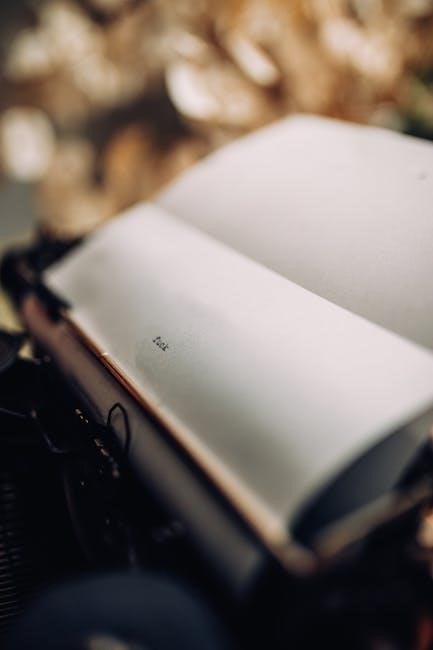
Key Components of a Typewriter Manual
Typewriter manuals include setup instructions‚ mechanical explanations‚ and troubleshooting tips. They cover installation‚ basic operations‚ and advanced adjustments‚ ensuring users can maintain and repair their machines effectively.
Setup and Installation Instructions
Typewriter manuals provide detailed setup and installation guides to ensure proper machine functionality. Instructions often include unpacking‚ assembling‚ and placing the typewriter on a sturdy surface. Steps for connecting power sources‚ installing ink ribbons‚ and aligning the carriage are typically outlined. Additional guidance may cover initial test typing to verify proper operation and adjusting margins for precise document formatting. These instructions are essential for both new users and experienced collectors‚ ensuring the typewriter is ready for optimal performance. Clear‚ step-by-step directions help users avoid common setup errors and maintain the machine’s longevity.
Basic Typewriter Mechanics
Typewriter manuals explain the fundamental mechanics of how these machines operate. They detail the role of typebars‚ which strike ink onto the page‚ and the platen‚ which feeds and aligns paper. Manuals describe the mechanism that links keystrokes to typebar movement‚ ensuring precise letter formation. Instructions often cover the function of the ink ribbon‚ which transfers ink to the paper‚ and how to adjust its tension for clear imprinting. Additionally‚ manuals provide insights into the escapement system‚ which controls paper advancement‚ and the carriage return mechanism. Understanding these basics is essential for effective typing and troubleshooting common issues‚ as outlined in the manual.
Advanced Features and Adjustments
Typewriter manuals often cover advanced features designed to enhance typing efficiency and customization. These include adjustable line spacing‚ margin controls‚ and impression regulators to modify keystroke force. Some models offer touch control mechanisms for lighter or heavier typing. Manuals detail how to fine-tune these settings for optimal performance. Additionally‚ instructions are provided for ribbon tension adjustments to ensure clear ink transfer. Advanced features like variable line spacing and specialized typing modes are also explained. These adjustments allow users to tailor the typewriter to their preferences‚ ensuring precision and consistency in their work. Manuals serve as invaluable guides for mastering these sophisticated mechanical capabilities.
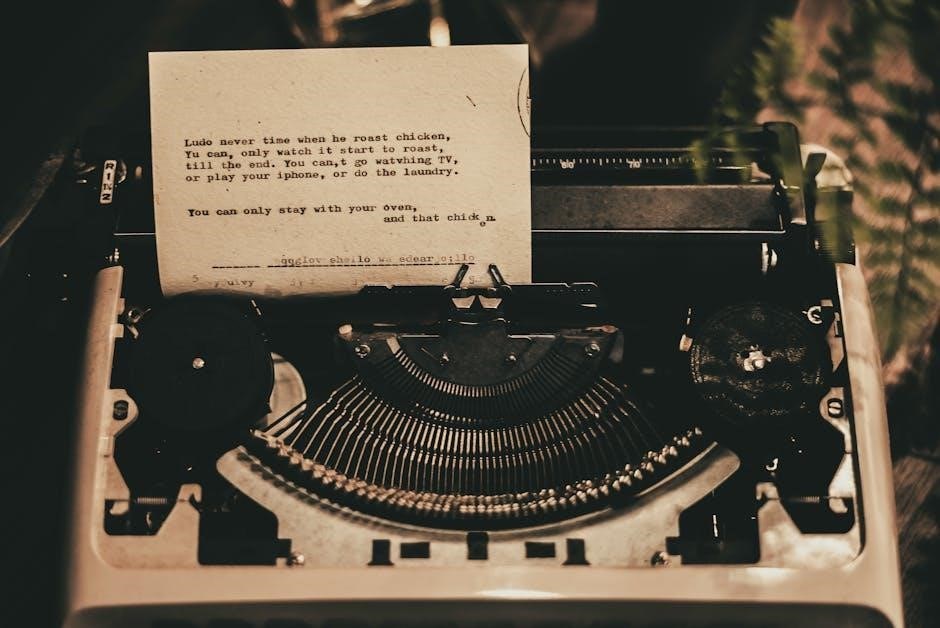
Troubleshooting Common Typewriter Issues
Typewriter manuals provide solutions for common issues like misalignment‚ jams‚ and ribbon wear. They offer step-by-step guides to diagnose and fix mechanical problems‚ ensuring smooth operation.
Alignment and Jamming Problems
Typewriter manuals often address common issues like misalignment and paper jams‚ which can disrupt typing. These guides provide detailed steps to adjust the print head‚ carriage‚ and feed mechanisms to ensure proper alignment. For jams‚ manuals typically recommend gently lifting the carriage to access the stuck paper and carefully removing it without forcing‚ to avoid damaging the internal mechanisms. Regular cleaning and lubrication of moving parts are also emphasized to prevent such issues. By following these troubleshooting steps‚ users can restore their typewriter’s functionality and maintain smooth operation. Proper alignment ensures crisp‚ evenly spaced text‚ while addressing jams promptly prevents further complications.
Ribbon and Ink Issues
Ribbon and Ink Issues
Typewriter manuals frequently address ribbon and ink-related problems‚ which are common due to wear and tear. Issues such as faded print or uneven ink distribution are often resolved by adjusting the ribbon tension or replacing it entirely. Manuals also guide users on how to clean ink buildup on typebars and rollers‚ ensuring consistent ink transfer. For models with ink ribbons‚ proper installation and alignment are stressed to prevent tangling or breaking. Additionally‚ some manuals include tips for extending ribbon life‚ such as using the correct thickness and avoiding excessive force while typing. Regular maintenance of these components is crucial for maintaining print quality and extending the typewriter’s lifespan.
Key Sticking and Mechanical Failures
Key sticking and mechanical failures are common issues addressed in typewriter manuals. These problems often arise from dust‚ debris‚ or worn parts. Manuals provide step-by-step guidance for cleaning typebars‚ lubricating mechanical components‚ and adjusting alignment to prevent sticking. Techniques such as soaking stuck keys in cleaning solutions or gently disassembling the mechanism are often recommended. Regular maintenance‚ like dusting with compressed air and applying silicone-based lubricants‚ can prevent these issues. Additionally‚ manuals may include tips for diagnosing more complex mechanical failures‚ such as faulty linkages or springs‚ and suggest when professional repair is necessary to restore functionality and ensure smooth operation.
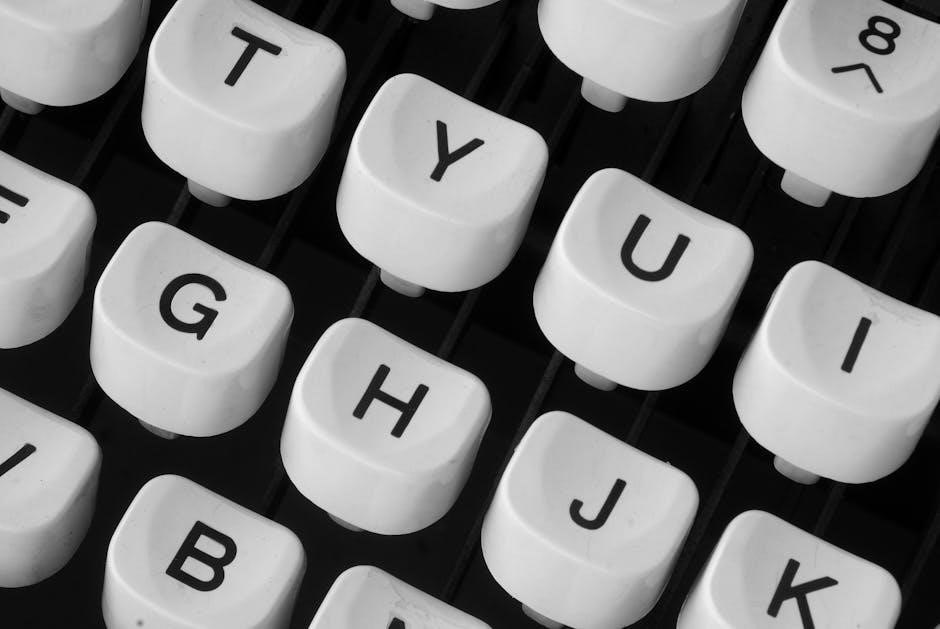
Maintenance and Cleaning Guides
Maintenance and cleaning guides in typewriter manuals emphasize regular upkeep to ensure longevity. Daily routines include dusting‚ lubricating‚ and inspecting parts for wear and tear‚ preventing mechanical issues.
Daily Maintenance Routines
Daily maintenance routines for typewriters involve regular cleaning and lubrication to ensure smooth operation. Users should dust the exterior and interior with a soft brush or cloth‚ paying attention to crevices where debris accumulates. Cleaning the keys and typebars with mild soap and water helps prevent sticking. Lubrication of moving parts‚ such as hinges and mechanisms‚ is essential to maintain functionality. It’s also important to inspect ribbons for wear and replace them when necessary. Proper alignment checks and margin adjustments should be performed regularly to ensure consistent typing quality. These simple steps can significantly extend the lifespan of a typewriter and keep it in optimal working condition.
Deep Cleaning and Lubrication
Deep cleaning and lubrication are crucial for maintaining typewriters‚ especially for vintage models. Start by disassembling the machine‚ carefully removing keys and other external components. Use a mild detergent and water solution to clean intricate parts‚ ensuring no residue remains. Lubricate mechanical linkages and pivot points with silicone-based oils to prevent rust and friction. Apply a thin layer of grease to gears and bearings for long-lasting protection. Avoid over-lubrication‚ as it can attract dust and dirt. After reassembly‚ test the typewriter to ensure all parts function smoothly. Regular deep cleaning preserves functionality and enhances the lifespan of the typewriter‚ keeping it operational for years.
Long-Term Storage Tips
For long-term storage‚ place the typewriter in a cool‚ dry environment to prevent rust and moisture damage. Use a hardshell case or airtight container to protect against dust and pests. Add silica gel packets to maintain humidity control. Avoid basements or attics with extreme temperature fluctuations. Before storing‚ clean the typewriter thoroughly and drain ink ribbons to prevent leakage. Remove any installed cartridges to avoid drying out. Cover the machine with a soft cloth to shield it from dust. Label the storage container for easy identification. Store the typewriter upright to prevent warping and ensure all parts remain aligned. Check on it biannually to ensure its condition remains stable. Proper storage preserves functionality and extends the typewriter’s lifespan for future use.

Downloading and Accessing Typewriter Manuals
Typewriter manuals can be downloaded from online archives‚ offering PDF formats for vintage models. Popular brands like Brother and IBM provide accessible guides for easy reference.
Popular Brands with Available Manuals
Manuals for iconic brands like Brother‚ IBM‚ Royal‚ and Underwood are widely available online. These guides cover setup‚ maintenance‚ and troubleshooting‚ ensuring longevity for vintage machines. Olivetti‚ Remington‚ and Hermes also offer accessible manuals‚ catering to enthusiasts and collectors. Platforms like Typewriters.com and specialized archives provide downloadable PDFs‚ making it easy to restore and operate classic typewriters. Whether you own a Brother Deluxe or an Olivetti Portable‚ these resources are invaluable. They not only preserve the functionality of these devices but also serve as a bridge between past and present‚ keeping the legacy of manual typewriters alive for future generations.
Online Resources for Vintage Manuals
Several online platforms offer vintage typewriter manuals‚ catering to collectors and enthusiasts. Websites like Typewriters.com provide downloadable PDFs for various models‚ including IBM Wheelwriter and Brother typewriters. Additionally‚ iStock and other stock image sites feature high-quality illustrations of manual typewriters‚ useful for reference. Online forums and communities dedicated to typewriter restoration often share scanned manuals and guides. These resources are invaluable for maintaining and repairing classic machines. They ensure that the knowledge and functionality of vintage typewriters are preserved for future generations. Whether you’re a collector or a hobbyist‚ these online archives are essential for keeping your typewriter in optimal condition.
PDF and Digital Formats for Manuals
PDF and digital formats have revolutionized access to typewriter manuals‚ offering convenience and preservation. Many vintage manuals are now scanned and available as downloadable PDFs‚ ensuring their longevity. These digital versions retain the original content’s integrity‚ including detailed diagrams and instructions. Websites like Typewriters.com and specialized forums provide free access to these resources‚ covering models from brands like IBM‚ Brother‚ and Hermes. Digital formats also enable easy searches and instant access‚ making maintenance and restoration more efficient. This shift to digital ensures that valuable information about typewriters remains accessible to future generations of collectors and enthusiasts‚ preserving both history and functionality.
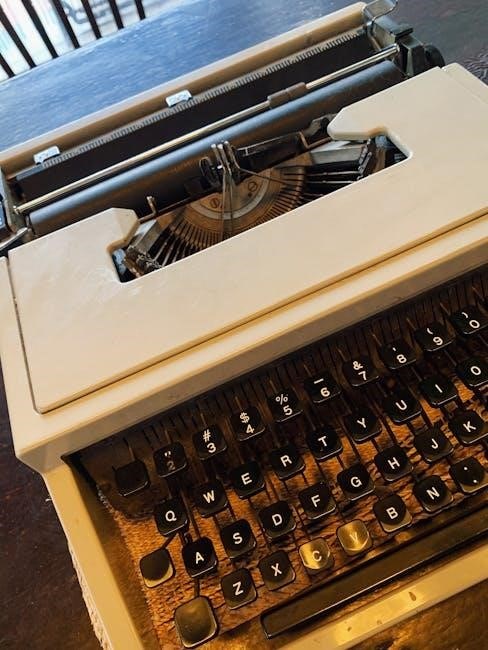
Restoration and Repair Guides
Restoration and repair guides provide step-by-step instructions for reviving vintage typewriters. These resources include mechanical theory‚ troubleshooting‚ and tools‚ helping enthusiasts restore functionality and preserve history.
Basic Restoration Steps
Basic restoration steps involve cleaning‚ disassembling‚ and inspecting the typewriter. Start by removing dirt and grime using soft brushes and mild detergents. Dismantle non-essential parts to access inner mechanisms. Inspect for rust or worn components‚ replacing them when necessary. Lubricate moving parts to ensure smooth operation. Reassemble carefully‚ ensuring alignment and functionality. These initial steps restore the typewriter to working condition‚ preserving its historical value. Proper tools and manuals are essential for a successful restoration‚ helping enthusiasts bring their vintage machines back to life.
Advanced Repair Techniques
Advanced repair techniques involve intricate processes like dismantling complex mechanisms‚ such as the keyboard or carriage system‚ to address deep-seated issues. Rebuilding the typewriter’s escapement mechanism ensures precise typing alignment‚ while recalibrating the carriage return spring restores smooth line advancement. Professionals often replace worn-out feed rollers and refine the ink ribbon system for consistent ink flow. Specialized tools‚ like escapement adjustment gauges‚ are essential for these tasks. Welding or fabricating small parts may be necessary for machines with rare or damaged components. Advanced techniques require patience‚ precision‚ and a deep understanding of the typewriter’s internal workings to restore functionality and performance effectively.
Tools and Parts for Restoration
Restoring a typewriter requires specialized tools and parts to ensure authenticity and functionality. Essential tools include screwdrivers for dismantling‚ escapement adjustment gauges‚ and precision cleaners for delicate mechanisms. Replacement parts like feed rollers‚ carriage springs‚ and ink ribbons are often sourced from vintage suppliers or online marketplaces. Lubricants‚ such as silicone oil‚ are crucial for maintaining smooth mechanical operation. Rare components‚ like specific gears or levers‚ may need custom fabrication or sourcing from dedicated typewriter enthusiasts. Having the right tools and parts is vital for achieving professional-grade restoration and preserving the typewriter’s original charm and performance.

The Role of Typewriter Manuals in Collecting
Typewriter manuals are invaluable for collectors‚ offering restoration guidance‚ maintenance tips‚ and historical insights that enhance the preservation and appreciation of vintage typewriters.
Collecting Rare and Vintage Manuals
Collecting rare and vintage typewriter manuals has become a niche hobby‚ offering a glimpse into the history of typing technology. These manuals‚ often sought by enthusiasts‚ provide detailed restoration guides‚ troubleshooting tips‚ and insights into the mechanics of iconic typewriter models. Manuals for brands like Brother‚ Olympia‚ and Hermes are particularly prized‚ as they offer step-by-step instructions for maintenance and repair. Many collectors value these documents for their historical significance‚ while others rely on them to restore and preserve vintage typewriters. Online archives and collector communities have made it easier to access and trade these manuals‚ ensuring their legacy endures.
Manuals as a Resource for Collectors
Manuals are invaluable resources for typewriter collectors‚ offering detailed insights into the functionality‚ maintenance‚ and historical context of vintage machines. They provide step-by-step guides for restoration and repair‚ enabling collectors to preserve their typewriters effectively. Additionally‚ these manuals often include diagrams and specifications‚ which help in identifying rare models and authenticating parts. Many enthusiasts rely on manuals to troubleshoot common issues like jamming or mechanical failures‚ ensuring their typewriters remain operational. By serving as both instructional tools and historical documents‚ typewriter manuals have become essential assets in the collector community‚ bridging the gap between preservation and practical use.
Preserving Typewriter History
Typewriter manuals play a crucial role in preserving the history of these iconic machines. They document the evolution of design‚ functionality‚ and technological advancements over the years. Manuals often include detailed diagrams‚ parts lists‚ and operational insights‚ serving as invaluable resources for historians and collectors. By providing instructions for maintenance and repair‚ they help ensure that vintage typewriters remain functional and authentic. Additionally‚ manuals offer a glimpse into the cultural and industrial contexts of their time‚ making them essential for understanding the impact of typewriters on society. As physical artifacts‚ they complement the machines themselves‚ creating a comprehensive archive of typewriter history for future generations;

Cultural Impact of Typewriter Manuals
Typewriter manuals highlight the enduring legacy of mechanical typewriters‚ inspiring nostalgia and creativity. Their resurgence reflects a cultural appreciation for tactile writing experiences in a digital age.
Typewriters in Literature and Film
Manual typewriters have long been iconic symbols in literature and film‚ often representing creativity and intellectualism. Authors like Cormac McCarthy and Ernest Hemingway famously used them to craft their masterpieces. In cinema‚ typewriters frequently appear as central props‚ evoking nostalgia and emphasizing the tactile process of writing. Films like Finding Forrester and The Shining showcase typewriters as tools of artistic expression. Their presence in stories underscores the emotional connection between writers and their machines‚ highlighting the manual typewriter’s enduring cultural significance beyond mere functionality.
The Revival of Manual Typewriters
Manual typewriters have experienced a resurgence in popularity‚ appealing to writers and hobbyists seeking a tactile‚ distraction-free writing experience. In a world dominated by digital technology‚ these machines offer a refreshing simplicity. Collectors and enthusiasts have driven the demand for refurbished models‚ with brands like Olivetti‚ Remington‚ and Underwood gaining newfound appreciation. The revival is also fueled by younger generations discovering the charm of mechanical keyboards and the satisfaction of physical typing. As a result‚ manual typewriters are no longer just vintage relics but tools for creative expression‚ blending nostalgia with practicality in modern times.
Typewriter Manuals in Modern Times
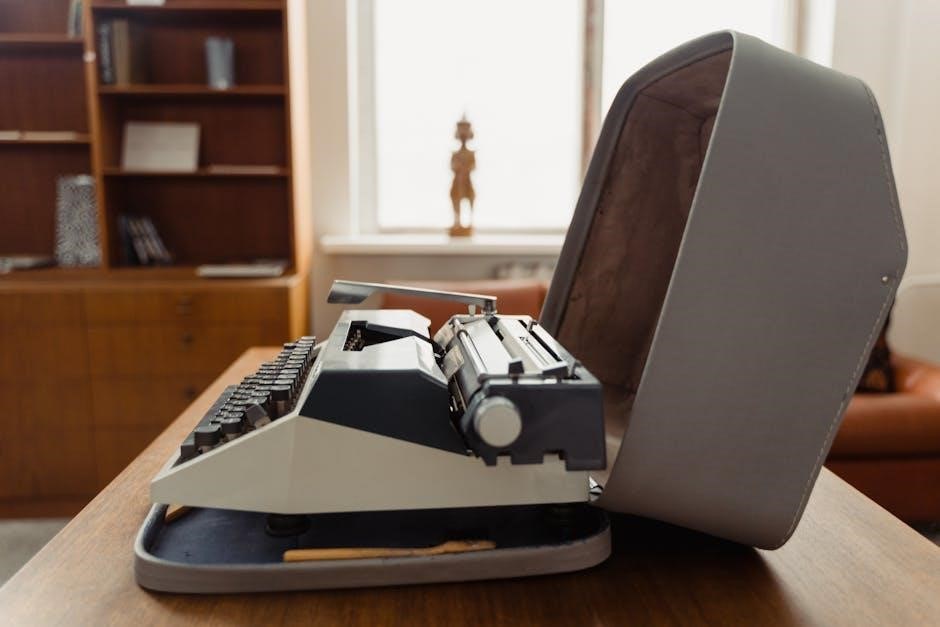
Typewriter manuals remain essential resources in the digital age‚ offering detailed guidance for enthusiasts and collectors. With the rise of online platforms‚ vintage and modern typewriter manuals are now widely available in PDF formats‚ enabling easy access for restoration and maintenance. These manuals cater to both novice and experienced users‚ providing step-by-step instructions for troubleshooting and repair. Brands like Brother‚ IBM‚ and Hermes have their manuals archived online‚ ensuring the preservation of typewriter history. Additionally‚ digital manuals support the growing community of manual typewriter restorers‚ who rely on these guides to restore and maintain their machines. This digital accessibility has reinvigorated the hobby‚ keeping typewriters relevant in modern times.
